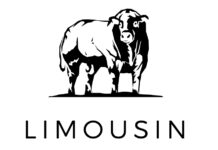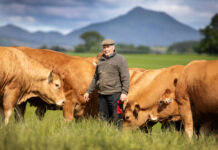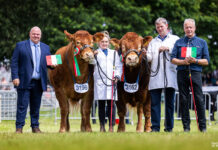British Limousin is the largest numerical beef breed in the United Kingdom accounting for 28% of the 1.7 million cattle registered with the British Cattle Movement Service (BCMS). It has held this position since BCMS was established in 1996.
Each year approximately 500,000 Limousin-sired cattle are registered, representing an annual industry value of around £600 million. It is further estimated that some 75% of all beef cattle in the UK carry a percentage of Limousin genetics.
In the twenty years since BCMS was first established, close on 12 million calves (11,814,453), sired by Limousin bulls, have been registered.
Limousin is the leading numerical beef breed in each of the four home nations.
These figures come on the back of what was another very successful year for the Limousin breed and British Limousin Cattle Society. Highlights from 2016 include:
- BLCS sales of pedigree Limousin cattle grossed over £5.6Million.
- Over 19,000 pedigree calves were also registered by the Society’s 2,800 breeder members – the sixth straight year that the 19,000 barrier has been broken.
- Top priced female for 2016 came from the noted Millington Herd with Millington Highlight selling for 50,000gns at their Dispersal Sale in August at Carlisle
- At the summer 2016 ‘Royal’ show majors, pedigree Limousin cattle secured interbreed wins at the Royal Ulster, Royal Highland, Great Yorkshire, and Royal Welsh Shows
£1 Million investment in ten year breed improvement plan:
In 2015, in a UK beef industry first, Genomic Breeding Values (GEBVs) for a range of new carcase traits were made available for all Limousin cattle. Work to develop GEBV’s continued through 2016 which culminated with the release of GEBV’s for female fertility and calf survival traits mid way through 2017.
These GEBVs will help to deliver breeding stock that:
- Finish at required carcase weights
- Finish quickly
- Have quality conformation and fat grades
Benefits of high GEBV sires is estimated at £100-£150/calf (source: SRUC)
Also in 2015, Limousin became the main breed in the DEFRA £1.5 Million project to develop EBVs for traits relating to Feed Efficiency. In 2016 a significant milestone was reached with the contracting of two commercial farms to record feed efficiency traits. Specialised equipment was installed on both farms to record feed intake and performance of growing beef cattle over the next two years. The data collected will be used to generate tools that will drive forward the genetic selection of cattle for feed use efficiency. Work currently being carried out at Scotland’s Rural College to collect feed intake records will continue until 500 cattle have been recorded over five batches.
The delivery of GEBVs is the first step of a progressive and long-range Breed Improvement Plan announced by the BLCS in 2014. The plan will see an overall investment of more than £1 Million by the Society. The estimated improvement in performance and genetics delivered through the plan could be worth an extra £50 Million per annum to commercial producers using Limousin cattle. The breeding goals outlined include:
- Solutions to identify and improve feed efficiency
- Improving the rate of gain in growth and carcase traits
- Improving cow production efficiency and maternal traits
Breed History:
First imported into the United Kingdom from France in 1971, the Limousin breed has built its reputation on being ‘The Carcase Breed’, a breed able to produce quality beef with a low proportion of bone and fat. Its influence on British Beef production has been borne through its advantages in calving ease, growth, milk, fertility, feed efficiency, killing-out percentage and meat yield.
The Limousin’s ability to produce ½ bred and ¾ bred carcases with excellent conformation, a top killing out percentage and a top yield of saleable meat (73.3%) make it well suited to the market needs of a consistent, quality beef product. An early maturing breed, the Limousin provides young but mature beef in the medium weight range demanded both by butchers and supermarkets.
Limousin bulls are known for their fleshing qualities, lighter bone, fertility, and for the extra conformation they pass to all progeny, whatever the dam. Limousin suckler cows can be found on both upland and lowland systems. They are renowned for ease of calving and ease of management, vital factors in today’s farming economy. A good milking ability and excellent fertility is complemented by a natural hardiness and thriftiness.
The British Limousin story is a remarkable one that the breed can tell over 45 years in the United Kingdom. From the initial import application to the UK Ministry made back in the 1960s, followed by the few pioneers importing those first 178 cattle, the breed – which was largely unknown to UK farmers – has now become the foremost in the country and is the industry benchmark for beef producers.
How has this happened? There are so many factors, breed pioneers and leaders, Society Councils and Chairmen have all played their parts, but mainly it is the quality of the breed, in harness with the commercial producers focussed on profit, who have driven this success. We all have come to know the attributes of the Limousin during this period; a breed unique in the beef industry, perfectly suitable for the suckler producer, easy calved, good liveability with good growth; for the finisher, easy fleshed with good conformation and good feed conversion; for the meat processor, so versatile with excellent meat yields; and for the retailer, lean beef with a fine tender grain.
For further information on the Limousin breed visit: www.limousin.co.uk
















